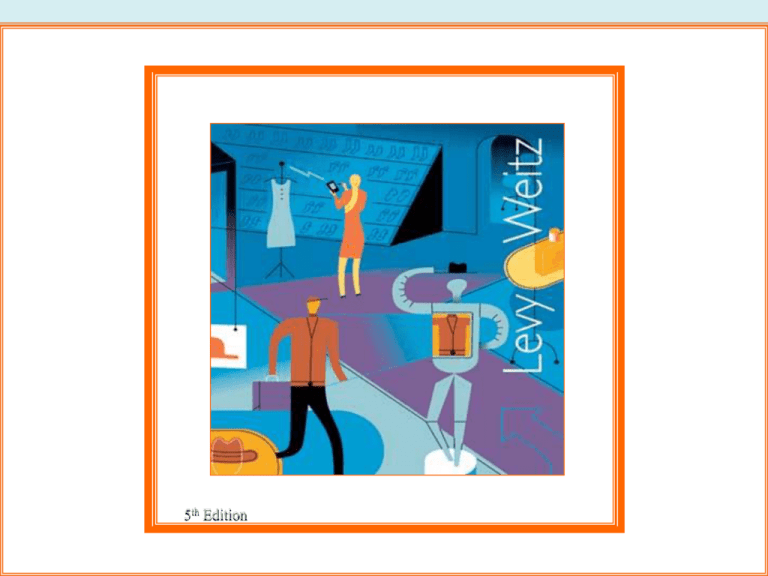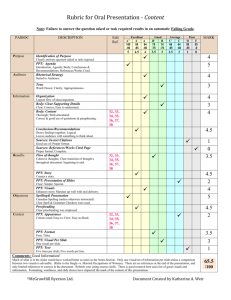
5th Edition
PPT 13-1
Chapter 13
Buying Systems
McGraw-Hill/Irwin
PPT
13-2 Retailing Management, 5/e
Levy/Weitz:
Copyright © 2004 by The McGraw-Hill Companies, Inc. All rights reserved.
Merchandise Management
Planning
Merchandise
Assortments
Retail
Communication
Mix
Buying
Systems
Buying
Merchandise
PPT 13-3
Pricing
Merchandise Management Issues
PPT 13-4
Types of Buying Systems
Staple Merchandise
Fashion Merchandise
Predictable Demand
Unpredictable Demand
History of Past Sales
Limited Sales History
Relatively Accurate Forecasts
Difficult to Forecast Sales
PPT 13-5
Staple Merchandise Buying System
Forecast
SKU
Sales
PPT 13-6
Order
Merchandise
Monitor
Sales and
Inventory
Compare
Inventory
to Basic
Stock List
Considerations in Determining
How Much to Order
• Basic Stock Plan
• Present Inventory
• Merchandise on
Order
• Sales Forecast
– Rate of Sales of
SKU (Velocity)
– Seasonality
PPT 13-7
Inventory Management Report for
Rubbermaid Merchandise
PPT 13-8
Basic Stock List
Indicates the Desired Inventory Level for Each SKU
– Amount of Stock Desired
Lost Sale Due
to Stockout
Cost of Carrying
Inventory
PPT 13-9
Inventory investment Dollars
Relationship between Inventory
Investment and Product Availability
600
500
400
300
200
100
0
80
85
90
95
Product Availability (Percent)
PPT 13-10
100
Cycle and Buffer Stock
Units Available
150 -
Order 96
Cycle
Stock
100 Buffer
Stock
50 -
0-
1
2
3
Weeks
PPT 13-11
4
Buffer Stock
We need it so we won’t loose sales, complementary sales, and customers
Buffer stock is dependent on:
-Forecast interval variance (Forecast interval = lead
time + review time)
-Variation in Demand (actual demand - forecasted
demand)
-Time to Get Product from Supplier
-Time to Get Product from Distribution
Center
- Product availability requested of IM systems
PPT 13-12
Forecasting Demand
Forecasting -- extrapolating
the past into future using
statistical and mathematical
methods
Objectives:
– Ignore random
fluctuations in demand
– But be responsive to real
change
PPT 13-13
Forecasting Sales
•
Tradeoff Recent Sales Against Past History of Sales
–
•
•
Exponential Smoothing
Old
Forecast
=
84
=
Old
Forecast
96
+
ά x (Recent – Old)
Demand Forecast
+
.5 x (72
ά ranges for 0 to 1
–
PPT 13-14
Recognize Recent Trends, But Don’t Over Weight Recent
Experience
Higher ά Weighs Recent Sales More
– 96)
Order Point
• Order point = the point at which inventory
available should not go below or else we will
run out of stock before the next order arrives.
• Assume Lead time = 0, Order point = 0
• Assume Lead time = 3 weeks, review time =
1 week, demand = 100 units per week
• Order point = demand (lead time + review
time) + buffer stock
• Order point = 100 (3+1) = 400
PPT 13-15
Order Point continued
• Assume Buffer stock = 50 units, then
• Order point = 100 (3+1) + 50 = 450
• We will order something when order point gets
below 450 units.
PPT 13-16
Calculating the Order Point
Order Point = (Demand/Day) x (Lead Time
+Review Time) + Backup Stock
167 units = (7 units x (14 + 7 days) + 20 units
So Buyer Places Order When Inventory in Stock
Drops Below 167 units
PPT 13-17
Merchandise Budget Plan
• Plan for the financial aspects of a merchandise
category
• Specifies how much money can be spent each
month to achieve the sales, margin, inventory
turnover, and GMROI objectives.
• Not a complete buying plan--doesn’t indicate
what specific SKUs to buy or in what quantities.
PPT 13-18
Six-Month Merchandise
Budget Plan for Men’s Tailored Suits
PPT 13-19
Steps in Preparing Plan
• Forecast Six Month Sales for Category
• Breakdown Total Sales Forecast into Forecast for each
Month (lines 1, 2)
• Plan Reductions for Each Month (lines 3, 4)
• Determine Beginning of the Month (BOM) Stock to
Sales Ratio (line 5)
• Calculate BOM Inventory (line 6)
• Calculate EOM Inventory (line 7)
• Calculate Monthly Additions to Stock (line 8)
PPT 13-20
Open to Buy
• Monitors Merchandise Flow
• Determines How Much Was Spent
and How Much is Left to Spend
PPT 13-21
Six Month Open to Buy
PPT 13-22
Open-to-buy for Past Periods
• Projected EOM stock = actual EOM stock
• Open-to-buy = 0
• There is no point in buying merchandise
for a month that is already over.
PPT 13-23
Open-to-Buy for
Current Period (I)
• Projected EOM stock =
• Actual BOM stock
• + Actual monthly additions to stock (what was
actually received)
• + Actual on order (what is on order for the
month)
• - Plan monthly sales
• - Plan reductions for the month
PPT 13-24
Open-to-Buy for
Current Period (II)
• Open-to-buy =
• Planned EOM stock (from merchandise budget
plan)
– Projected EOM stock (based on what is really
happening)
PPT 13-25
Allocating
Merchandise to Stores
Fewer Sales,
More Inventory
More Sales,
Less Inventory
Percentage of total sales
1
1.5
2.5
3.5
4
6
8
12
Percentage of total inventory
1.5
2
3
4
4
4
6
10
PPT 13-26
Breakdown by Store of
Traditional $35 Denim Jeans in Light Blue
(1)
(2)
(3)
TYPE OF
STORE
NUMBER OF
STORES
% OF TOTAL
SALES, EACH
STORE
A
4
10.0%
B
3
C
8
(4)
(5)
(6)
SALES PER
SALES PER
UNIT SALES
STORE (TOTAL
STORE TYPE
PER STORE
SALES X COL. 3) (COL. 2 X COL. 4) (COL. 4/$35)
$15,000
60,000
429
6.7
10,000
30,000
286
5.0
7,500
60,000
214
Total sales $150,000
Source: Banner Distributing Company, Denver, Colorado; used with
permission.
PPT 13-27
ABC Analysis
Rank - orders merchandise by some
performance measure determine which items:
– should never be out of stock.
– should be allowed to be out of stock
occasionally.
– should be deleted from the stock selection.
PPT 13-28
Analyzing Merchandise Management
Merchandise Performance
– ABC Analysis
– Sell Through Analysis
Vendor Analysis
– Multiattribute Method
PPT 13-29
ABC Analysis Rank Merchandise
By Performance Measures
• Contribution Margin
• Sales Dollars
• Sales in Units
• Gross Margin
• GMROI
• Use more than one criteria
PPT 13-30
ABC Analysis for Dress Shirts
C
Percentage of Sales Dollars
10%
B
20%
100
Sales
90
80
70
60
A
50
70%
40
30
20
No Sales
10
0
10
A
5%
B
10%
20
30
40
50
60
70
C
65%
Percentage of Items
PPT 13-31
80
90
D
20%
100
Sell-through Analysis for Blouses
Stock
Number
1011 -Sm
Description
Week 1
Week 2
Actual-to-Plan
Actual-to-Plan
Plan Actual Percent. Plan Actual Percent.
White silk V-neck
20
15
-25
20
10
-50
1011 -Med White Silk V-neck
30
25
-16.6
30
20
-33
1011 -Lg
White Silk V-neck 20
16
-20
20
16
-20
1012 -Sm
Blue Silk V-neck
25
26
4
25
27
8
1012 -Med Blue Silk V-neck
35
45
29
35
40
14
1012 -Lg
25
25
0
25
30
20
PPT 13-32
Blue Silk V-neck
Evaluating a Vendor:
A Weighted Average Approach
n
I j * P ij
= Sum of the expression
i1
PPT 13-33
Ij
= Importance weight assigned
to the ith dimension
Pi
= Performance evaluation for
jth brand alternative on the
jth issue
1
= Not important
10
= Very important
Evaluating a Vendor:
A Weighted Average Approach
Performance Evaluation of Individual
Brands Across Issues
Issues
Importance
Evaluation
of Issues (I)
(1)
Vendor reputation
Service
Meets delivery dates
Merchandise quality
Markup opportunity
Country of origin
Product fashionability
Selling history
Promotional assistance
Overall evaluation = n
(2)
9
8
6
5
5
6
7
3
4
I *P
j
i 1
PPT 13-34
ij
Brand A Brand B Brand C Brand D
(Pa)
(Pb)
(Pc)
(Pd)
(3)
5
6
5
5
5
5
6
5
5
290
(4)
9
6
7
4
4
3
6
5
3
298
(5)
4
4
4
6
4
3
3
5
4
212
(6)
8
6
4
5
5
8
8
5
7
341
Retail Inventory Method (RIM)
Two Objectives:
– To maintain a perpetual or book inventory of retail
dollar amounts.
– To maintain records that make it possible to
determine the cost value of the inventory at any time
without taking a physical inventory.
PPT 13-35
Advantages of RIM
• The retailer doesn't have to “cost” each time.
• Follows the accepted accounting practice of
valuing assets at cost or market, whichever is
lower.
PPT 13-36
Advantages of RIM cont’d
• Amounts and percentages of initial markups,
additional markups, markdowns, and shrinkage
can be compared with historical records or
industry norms.
• Useful for determining shrinkage.
• Can be used in an insurance claim case of a loss.
PPT 13-37
Disadvantages of RIM
• System that uses average markup.
• Record keeping process involved is burdensome.
PPT 13-38
Steps in RIM
Calculate Total Merchandise Handled at Cost
and Retail
Calculate Retail Reductions
Calculate Cumulative Markup and Cost Multiplier
Determine Book Inventory at Cost and Retail
PPT 13-39
Retail Inventory Method
Cumulative Markon = (total retail - total cost) / total retail:
($290,000 - $160,000) / $290,000 = 44.8%
The Cost Multiplier = cumulative markon
(100% - cumulative markon%) = 55.2%
PPT 13-40
Ending book
inventory at retail
= total goods handled at retail - total
reductions: $290,000 - $208,000 = $82,000
Ending book
inventory at cost
= ending book inventory at retail x cost
multiplier: $82,000 x 55.2% = 45,264
Retail Inventory Method
Example
Total Goods Handled
Cost
Beginning inventory
Retail
$ 60,000
$ 84,000
Purchases
50,000
70,000
- Return to vendor
(11,000)
(15,400)
Net Purchases
39,000
54,600
Additional markups
4,000
- Markup cancellations
(2,000)
Net markups
2,000
Additional Transport.
Transfers in
- Transfers out
Net Transfers
Total Goods Handled
PPT 13-41
1,000
1,428
2,000
(714)
(1,000)
714
(1,000)
$100,714
$141,600
Retail Inventory Method
Example
Total Goods Handled
Cost
Retail
Gross Sales
$ 82,000
- Consumer Returns & Allowances
( 4,000)
Net Sales
Markdowns
6,000
- Markdown Cancellation
(3,000)
Net Markdown
3,000
Employee Discounts
3,000
Discounts to Customers
Estimated Shrinkage
Total Reductions
PPT 13-42
$ 78,000
500
1,500
$ 86,000





